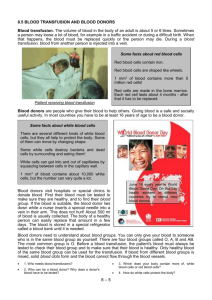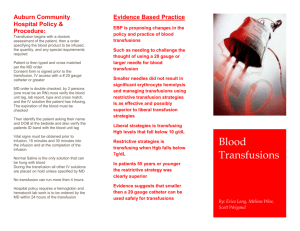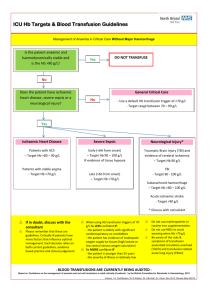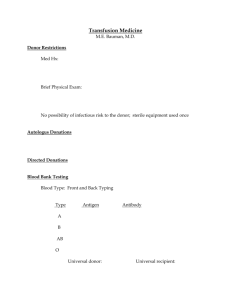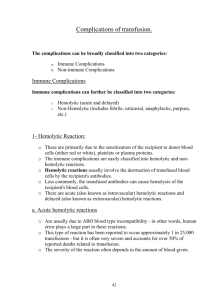trali
advertisement
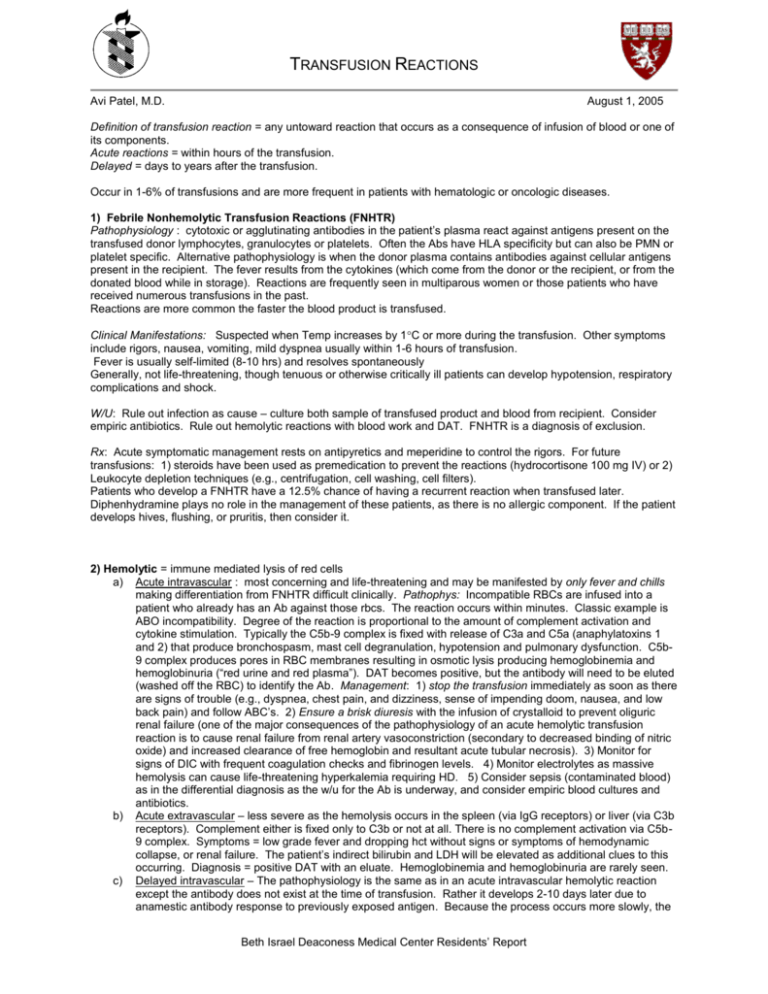
TRANSFUSION REACTIONS Avi Patel, M.D. August 1, 2005 Definition of transfusion reaction = any untoward reaction that occurs as a consequence of infusion of blood or one of its components. Acute reactions = within hours of the transfusion. Delayed = days to years after the transfusion. Occur in 1-6% of transfusions and are more frequent in patients with hematologic or oncologic diseases. 1) Febrile Nonhemolytic Transfusion Reactions (FNHTR) Pathophysiology : cytotoxic or agglutinating antibodies in the patient’s plasma react against antigens present on the transfused donor lymphocytes, granulocytes or platelets. Often the Abs have HLA specificity but can also be PMN or platelet specific. Alternative pathophysiology is when the donor plasma contains antibodies against cellular antigens present in the recipient. The fever results from the cytokines (which come from the donor or the recipient, or from the donated blood while in storage). Reactions are frequently seen in multiparous women or those patients who have received numerous transfusions in the past. Reactions are more common the faster the blood product is transfused. Clinical Manifestations: Suspected when Temp increases by 1C or more during the transfusion. Other symptoms include rigors, nausea, vomiting, mild dyspnea usually within 1-6 hours of transfusion. Fever is usually self-limited (8-10 hrs) and resolves spontaneously Generally, not life-threatening, though tenuous or otherwise critically ill patients can develop hypotension, respiratory complications and shock. W/U: Rule out infection as cause – culture both sample of transfused product and blood from recipient. Consider empiric antibiotics. Rule out hemolytic reactions with blood work and DAT. FNHTR is a diagnosis of exclusion. Rx: Acute symptomatic management rests on antipyretics and meperidine to control the rigors. For future transfusions: 1) steroids have been used as premedication to prevent the reactions (hydrocortisone 100 mg IV) or 2) Leukocyte depletion techniques (e.g., centrifugation, cell washing, cell filters). Patients who develop a FNHTR have a 12.5% chance of having a recurrent reaction when transfused later. Diphenhydramine plays no role in the management of these patients, as there is no allergic component. If the patient develops hives, flushing, or pruritis, then consider it. 2) Hemolytic = immune mediated lysis of red cells a) Acute intravascular : most concerning and life-threatening and may be manifested by only fever and chills making differentiation from FNHTR difficult clinically. Pathophys: Incompatible RBCs are infused into a patient who already has an Ab against those rbcs. The reaction occurs within minutes. Classic example is ABO incompatibility. Degree of the reaction is proportional to the amount of complement activation and cytokine stimulation. Typically the C5b-9 complex is fixed with release of C3a and C5a (anaphylatoxins 1 and 2) that produce bronchospasm, mast cell degranulation, hypotension and pulmonary dysfunction. C5b9 complex produces pores in RBC membranes resulting in osmotic lysis producing hemoglobinemia and hemoglobinuria (“red urine and red plasma”). DAT becomes positive, but the antibody will need to be eluted (washed off the RBC) to identify the Ab. Management: 1) stop the transfusion immediately as soon as there are signs of trouble (e.g., dyspnea, chest pain, and dizziness, sense of impending doom, nausea, and low back pain) and follow ABC’s. 2) Ensure a brisk diuresis with the infusion of crystalloid to prevent oliguric renal failure (one of the major consequences of the pathophysiology of an acute hemolytic transfusion reaction is to cause renal failure from renal artery vasoconstriction (secondary to decreased binding of nitric oxide) and increased clearance of free hemoglobin and resultant acute tubular necrosis). 3) Monitor for signs of DIC with frequent coagulation checks and fibrinogen levels. 4) Monitor electrolytes as massive hemolysis can cause life-threatening hyperkalemia requiring HD. 5) Consider sepsis (contaminated blood) as in the differential diagnosis as the w/u for the Ab is underway, and consider empiric blood cultures and antibiotics. b) Acute extravascular – less severe as the hemolysis occurs in the spleen (via IgG receptors) or liver (via C3b receptors). Complement either is fixed only to C3b or not at all. There is no complement activation via C5b9 complex. Symptoms = low grade fever and dropping hct without signs or symptoms of hemodynamic collapse, or renal failure. The patient’s indirect bilirubin and LDH will be elevated as additional clues to this occurring. Diagnosis = positive DAT with an eluate. Hemoglobinemia and hemoglobinuria are rarely seen. c) Delayed intravascular – The pathophysiology is the same as in an acute intravascular hemolytic reaction except the antibody does not exist at the time of transfusion. Rather it develops 2-10 days later due to anamestic antibody response to previously exposed antigen. Because the process occurs more slowly, the Beth Israel Deaconess Medical Center Residents’ Report d) presentation is less severe/dangerous. There may be slight fever, falling Hct, bilirubinemia. Hemoglobinemia and hemoglobinuria can occur but do not invariably occur. Treatment is supportive, including maintaining diuresis and hemodynamics, and assuring future blood products do not contain offending antigen.. Delayed extravascular – Generally involve the Rh system. The patient often has no symptoms other than a fever with falling hct and the development of a new DAT. 3) Allergic Transfusion Reactions Due to recipient antibody (IgG or IgE) directed against donor plasma proteins. Symptoms generally are mild urticaria and pruritis with skin erythema, though frank anaphylaxis can occur. Usually occurs rapidly, in seconds to minutes. Treatment generally is diphenhydramine but with anaphylaxis would need epi, vasopressors, airway management. Typically does not recur with subsequent transfusions. Can be difficult to distinguish in reality from FNHTRs. More severe in patients taking ACE-inhibitors b/c ACE is identical to kininase II the enzyme responsible for breaking down bradykinin. When bradykinin has a longer half-life, there is more flushing, hypotension etc. 4) Bacterial Contamination Can occur due to improper sterile technique during the acquisition of the blood product. Pseudomonas, Yersinia, Enterobacter and Flavobacterium along with Salmonella and Staphylococcus are the most common offending bugs. It is difficult to determine if a sample is contaminated by visual inspection. Typically, it’s discovered after the transfusion is given when the patient presents with symptoms of “warm shock.” It’s difficult to distinguish between this and FNHTR, but this is generally more severe. There is no hemoglobinuria or hemoglobinemia, so this does not often get confused with a hemolytic reaction. Send cultures from the recipient as well as from the transfused product. Start antibiotics empirically. 5) Transfusion-Related Acute Lung Injury (TRALI) – also called Noncardiogenic Pulmonary Edema o More commonly being recognized as a complication of blood transfusions, though first described in 1957. Said to occur in 1:2000 transfusions. o Risk factors: severe comorbid illness, massive transfusions, recent surgery, and longer storage of transfused products, active infection. Associated mainly with PRBCs, whole blood and FFP. Rarely associated with platelet transfusions, or transfusions of granulocytes or cryoprecipitate. o Diffuse pulmonary infiltrates develop within 4 hours of transfusion of RBCs or platelets in the absence of LV dysfunction (normal PCWP). However, has been described 1-2 days after transfusion. o Symptoms/Signs: dyspnea, cyanosis, fever, chills, tachypnea, hypoxia, pulmonary edema and hypotension usually within 2-4 hours. o 100% need oxygen support, 70% require mechanical ventilation, 6% mortality rate o Pathophysiology: Pulmonary agglutinin reaction. General theory = interaction of antibodies (90% of the time of donor origin) with WBCs of the recipient. (10% of the time, the patient’s antibodies react against donor WBCs.) WBCs are activated and are able to bind via adhesive molecules on their cell surface to the endothelial cells of the pulmonary vasculature and diapedese into the interstitial space. Here the PMNs degranulate and release destructive enzymes creating a capillary leak fluid fills the alveolar space. o 90% of the time the antibodies are identified when an extensive search is undertaken. 2 Hit Hypothesis was advanced in 1997 but has since been modified. First hit = predisposing serious illness in the patient Second Hit = transfusion of a blood product containing 1) leukocyte antibody directed against the patient’s WBC 2 ) biologically active lipids or 3) leukocyte antibody and biologically active lipid (that “primes” the PMNs by enhancing their NADPH oxidase activity). o Management: Fluids to maintain BP and cardiac output and ventilatory support. Diuretics and steroids have not proved helpful in the treatment of TRALI. Albumin infusions were tried in 3 patients with some effect, but more recently have been found to not be helpful. o Laboratory confirmation: The donors of all components transfused within 6 hours of the initiation of the reaction are screened for HLA Class I antibodies. If all are negative, then check for HLA Class II antibodies. If still negative, then check the recipient for leukocyte antibodies. Also, C3 and C5a levels will drop with the onset of TRALI and rise again 4-7 days later. o Donor of blood product = usually multiparous woman who has been sensitized to fetal antigens during pregnancy. In fact, leukoagglutinins are present in 18% of all parous women. Some debate whether a donor who has given a transfused specimen to a patient who later developed TRALI should ever donate blood again. People at particular risk are children whose mother’s donate blood products to them. o Pathology findings: very similar to ARDS picture - diffuse alveolar damage with edema and hyaline membrane formation, scant interstitial inflammation, alveolar cell hypertrophy. o Prevention: In theory, washed products should pose a lower risk, though this has never been proven. 6) Electrolyte Abnormalities Hypocalcemia – occurs due to the citrate used to preserve the blood for storage. The citrate binds the ionized calcium and can lead to clinically significant hypocalcemia if enough citrate/blood is transfused. Normally, the citrate is dealt with quickly as it’s converted by the liver into bicarbonate. Beth Israel Deaconess Medical Center Residents’ Report Hyperkalemia or Hypokalemia – both can occur, though hypokalemia is more common with large volume transfusions b/c as citrate is converted to bicarbonate, the patient’s serum becomes more alkalotic. 7) Graft versus Host Disease (GVHD) Occurs when immunologically competent lymphocytes are given into an immunocompromised host who cannot destroy the donor lymphocytes. The donor lymphocytes attack the tissues, particularly the bone marrow, leading to aplastic anemia and frequently death. Bypass this effect by using irradiated blood, though this shortens the half-life of the stored blood. 8) Hypothermia Occurs with rapid transfusion of large quantities of refrigerated blood products. 9) Post-Transfusion Purpura * occurs mainly in women, and with products containing platelets, ie red cells, platelets, granulocytes. * occurs 5-10 days after transfusion * immune mediated thrombocytopenia with the culprit antigen being PlA-1. * Rx: high dose steroids and exchange transfusion can be used but can take 1-2 weeks to work. Highdose IVIG is preferred therapy. Use washed products in future. Beth Israel Deaconess Medical Center Residents’ Report



